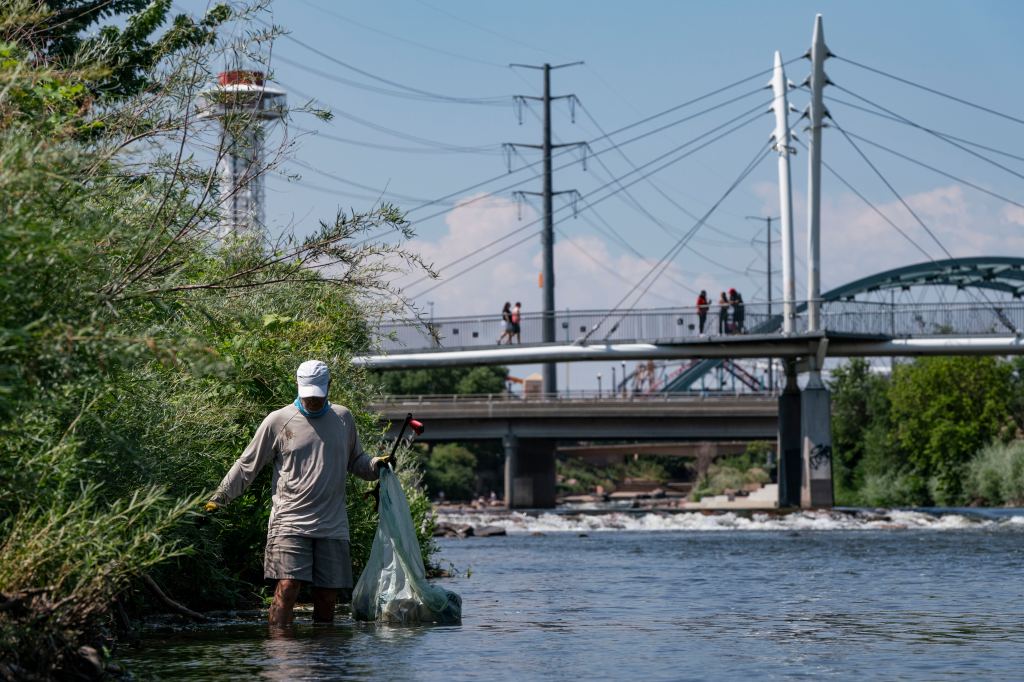Volunteers conducting cleanups along Denver’s South Platte River encounter a wide variety of cast-offs along its banks: shopping carts, food wrappers, guns — even obscure relics like car phones from the 1990s.
While a new era of river revitalization projects and riverside development plans is taking hold, water quality often remains below state standards. Some sections of the South Platte still stink. And despite a promise by former Denver Mayor Michael Hancock to make the river swimmable, city health officials still warn against going in the water — especially during the summer months.
“If you want to go swimming, go to a swimming pool — you’re much safer there,” said Jon Novick, the Denver Department of Public Health and Environment’s water quality program administrator.
The recent swell of attention on the South Platte — by developers, community leaders and city officials working to improve conditions — has highlighted the many environmental challenges still present.
Wastewater plants discharge effluent into the river, and companies such as Suncor Energy release a range of substances into the South Platte and the streams that flow into it. Among them: inorganic nitrogen, arsenic and the class of PFAS compounds known as “forever chemicals.”
Denver’s health department for decades has tracked a swath of contaminants as well as river conditions. The department monitors water temperature, acidity, nutrients and metals.
But the department’s biggest concern is E. coli bacteria, which can cause infections or sicken people if ingested, Novick said. E. coli can enter the water through animal or human waste. Denver’s aging infrastructure means that sometimes wastewater pipes leak sewage, which eventually reaches the river, he said. All of the city’s stormwater flushes to the South Platte.
The bacteria spreads faster in the warmer waters of summer, which is when people are most likely to want to take a dip. E. coli concentrations increase as the river flows downstream to the north.
In its most recent water quality report, published last October, the DDPHE ranked South Platte water quality as “fair” — above “marginal” and “poor,” but below “good.” E. coli levels exceeded the Colorado Water Quality Control Commission’s standard year-round in 2022. The river also exceeded standards for arsenic, which is naturally occurring in the bedrock under the city.
The river also suffers from the byproducts of the millions of people who live nearby. Anything on Denver’s streets and sidewalks not blown away or picked up eventually makes its way to the river: trash, lawn fertilizers, runoff from roads, pet waste, oil and grease from vehicles.
Part of the Mile High Flood District’s work is to help local governments better clean stormwater before it reaches the river.
The district — founded in the wake of Denver’s catastrophic 1965 flood — has tracked some positive trends in the river’s health. Nutrients like phosphorus and nitrogen have generally declined, said Holly Piza, the district’s research and development director. The nutrients from products like fertilizers can cause algae blooms and hurt aquatic ecosystems.
But other water quality issues are worsening, she said, including salinity — which hurts aquatic life and can damage infrastructure.
Attempts to mitigate the problem across Denver include a set of bioretention ponds outside the Carla Madison Recreation Center on Colfax Avenue. Those help retain water after rainfall and filter it through the dirt, instead of allowing all the water to flow immediately toward the river.
Novick and Piza urge Denverites to be more thoughtful: Don’t use fertilizers with phosphorus or nitrogen. Don’t litter. Wash your car at a car wash. Make sure sprinklers are watering grass, not pavement.
“There’s a ton the city is doing to improve water quality,” Novick said, “but we can’t be everywhere and we can’t do it all.”
Get more Colorado news by signing up for our Mile High Roundup email newsletter.
Originally Published:
